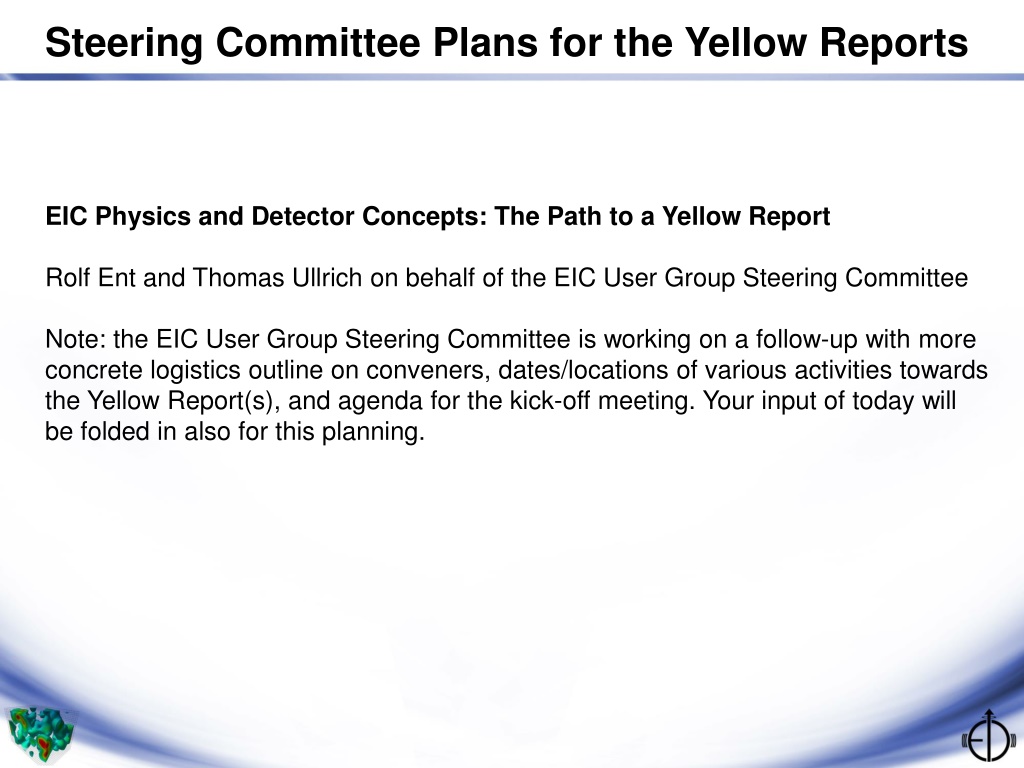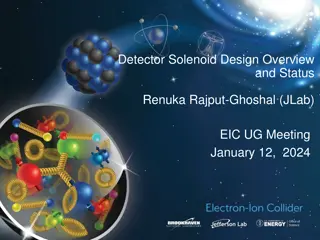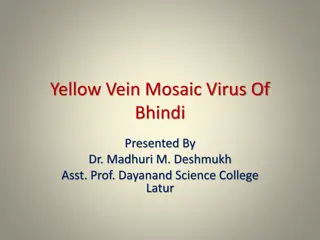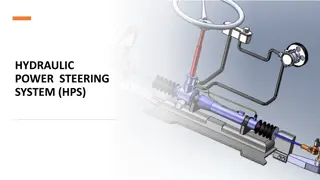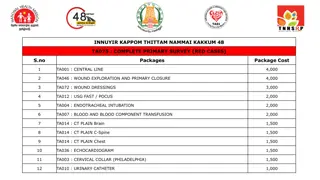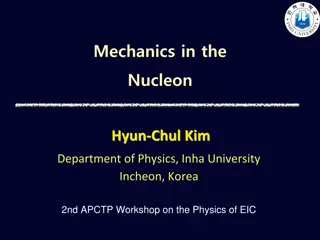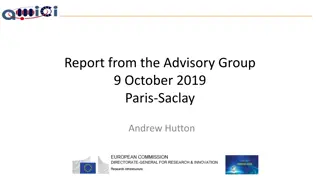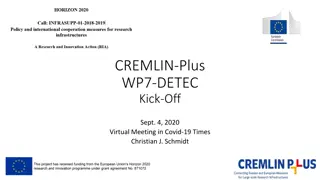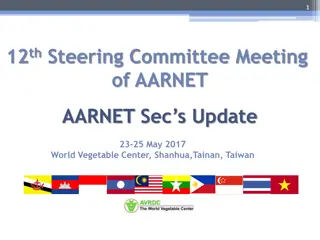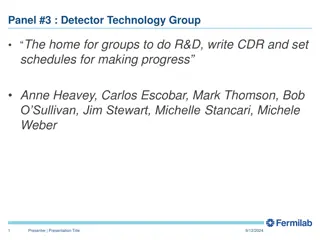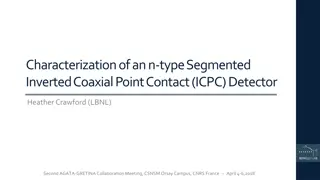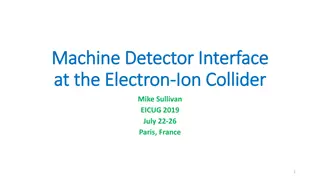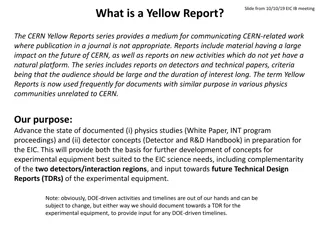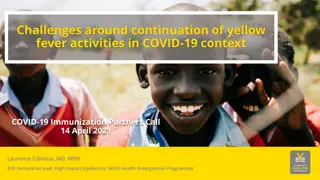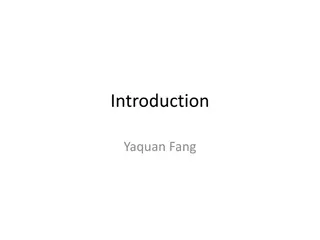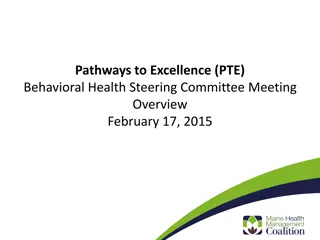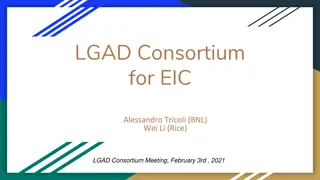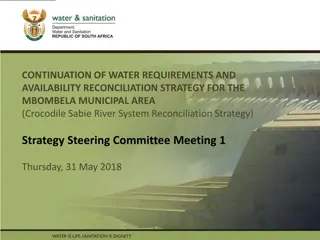EIC User Group Steering Committee Plans for Yellow Reports on Physics and Detector Concepts
The EIC User Group Steering Committee is focused on developing Yellow Reports to communicate important physics studies and detector concepts for the Electron-Ion Collider (EIC). These reports aim to advance experimental equipment concepts, complementarity of detectors, and provide input for future Technical Design Reports (TDRs), contributing to the EIC's science needs.
Download Presentation

Please find below an Image/Link to download the presentation.
The content on the website is provided AS IS for your information and personal use only. It may not be sold, licensed, or shared on other websites without obtaining consent from the author. Download presentation by click this link. If you encounter any issues during the download, it is possible that the publisher has removed the file from their server.
E N D
Presentation Transcript
Steering Committee Plans for the Yellow Reports EIC Physics and Detector Concepts: The Path to a Yellow Report Rolf Ent and Thomas Ullrich on behalf of the EIC User Group Steering Committee Note: the EIC User Group Steering Committee is working on a follow-up with more concrete logistics outline on conveners, dates/locations of various activities towards the Yellow Report(s), and agenda for the kick-off meeting. Your input of today will be folded in also for this planning.
2014 2015 2016 2017 2018 2019 2020 2021 2022 2023 2024 2025 2026 2027 2028 Activity Name NSAC Long Range Plan Timeline as shown at the 2019 EIC Users Group Meeting in Paris for discussion of Future Planning of user- group driven activities accompanying DOE-driven activities. NAS Study CD0 assumed DOE Driven CD1 (Down-select) CD2/CD3 NSAC LRP assumed EIC construction 2030 EIC physics case EICUG formation User Group Driven EICUG meetings Expression of Interest Physics/Detector book I Call for Detectors/ Collaboration Formation Design of Detectors Down-select to Two Full- Size Detectors Detector/IR TDRs, Detector/IR Construction CD0 = DOE Mission Need statement; CD1 = design choice and site selection CD2/CD3 = establish project baseline cost and schedule 2030
What is a Yellow Report? The CERN Yellow Reports series provides a medium for communicating CERN- related work where publication in a journal is not appropriate. Reports include material having a large impact on the future of CERN, as well as reports on new activities which do not yet have a natural platform. The series includes reports on detectors and technical papers, criteria being that the audience should be large and the duration of interest long. The term Yellow Reports is now used frequently for documents with similar purpose in various physics communities unrelated to CERN. Our purpose: Advance the state of documented (i) physics studies (White Paper, INT program proceedings) and (ii) detector concepts (Detector and R&D Handbook) in preparation for the EIC. This will provide both the basis for further development of concepts for experimental equipment best suited to the EIC science needs, including complementarity of the two detectors/interaction regions, and input towards future Technical Design Reports (TDRs) of the experimental equipment. Note: obviously, DOE-driven activities and timelines are out of our hands and can be subject to change, but either way we should document towards a TDR for the experimental equipment, to provide input for any DOE-driven timelines.
Strategy Quantify physics measurements for existing or new physics topics and implications for detector design ( Physics/Detector Group ) - Go beyond physics motivation to implication for detector requirements - Physics considerations for two independent complementary detectors Study detector concepts based on the requirements defined above, and quantify implications for the physics measurements ( Detector/Physics Group ) - Balance detector concepts versus impact on physics measurements. - Document complementarity (+ reduction of systematics) of detectors. - Fold in ancillary detectors, measurements (polarimetry, luminosity, ) - Engage EIC-detector R&D consortia Optional: Study opportunities for accelerator physics experiments at a future EIC - Accelerator scope is to deliver EIC for nuclear/particle physics - EIC will also be unique facility that can push frontiers of accelerator S&T - Likely smaller scale, 5-10 accelerator scientists
Approach Form physics/detector, detector/physics and accelerator physics working groups First two will likely have 3-4 conveners (= editors of final Reports), accelerator group likely will simply have Ferdi Willeke and Andrei Seryi as convener. Each group has 1 Steering Committee (SC) observer that follows progress and reports the status of the effort to the SC. The two physics/detector and detector/physics groups should have regular meetings (preferably weekly) via video conference/phone. At regular intervals (preferably monthly) both groups should have a joint meeting. Each group (physics and detector) will need to be divided in sub-groups, with sub-conveners. If we have an optional third accelerator group they likely can stay as one. Sub-groups will be defined following the analysis of the Request of Information . The sub-conveners will be the people being requested to guide and document the contributions (10-15 pages each) to the conveners for the Yellow Report(s).
Proposed Physics/Detector Sub-Groups First order we plan to follow the EICUG Request of Information call: Longitudinal (spin) nucleon structure 3D nucleon / nucleus structure High density parton physics Beyond Standard Model / Electro-weak physics Hadronization and fragmentation Nuclear Structure / Short-range correlations Origin of nuclear force Collective effects Spectroscopy Origin of mass Other (Entanglement, Jet studies, ) After analysis of the EICUG Request of Information gauging community interest the above scheme should be adjusted.
Proposed Detector/Physics Sub-Groups First order we plan to follow the EICUG Request of Information call: Tracking Vertexing Calorimetry Particle ID Forward instrumentation / Backward instrumentation IR design / Background studies Ancillary Measurements: Polarimetry, Luminosity Software / Computing DAQ / Slow Controls / Readout Other The three areas below have been added as they are important to study and document in the Yellow Reports: Magnetic field options (configuration, strength, impact on machine, IR compatibility) Arguments for 2 complementary detectors Overall design/integration After analysis of EICUG Request of Information the above scheme can be adjusted if needed.
Timeline 2019 October Early November Mid-December Information gathering stage Announce effort/plan and conveners Kick-off Meeting* (EICUG SC, Conveners, ) 2020 Mid-March Late May/Early June Second workshop* First workshop* August Status reports of main groups at EICUGM Mid-September Mid-November Third workshop* Fourth workshop* or Final Meeting (assembly of Yellow Report(s) 2021 January (optional) Final Meeting After assembly of Yellow Report(s), independent review team reads and comments, with final Yellow Report(s) to be released after folding in input. Goal is April 2021 (or, expedited January 2021). * all workshops close to major airport, folding in different geographic regions
EIC User Engagement The current accelerator and detector concepts are now in a state that with the simulation and software tools developed by the EICUG quantitative physics and detector studies can be done. EIC community engagement may, based on common interest, naturally evolve into proto-collaboration formation, independent of hosting site. It is vital for this effort that a large fraction of the active participants come from university groups. If it ends up with the labs carrying out the lion share of the work the effort will miss its goals. - We should aim to engage (at least!) 10% of the ~950 members of the EICUG in this effort. - We will integrate detector concepts with the ongoing EIC detector R&D program, to provide a strong synergy, but also encourage new groups to come in, keeping in mind the goal of two complementary full detectors. - This effort needs substantial participation from universities willing to invest some amount of their time in calendar year 2020 to this project. Yes, we are all busy, but the EIC time seems now! - It is essential, EIC activities in DOE seem to proceed fast.
